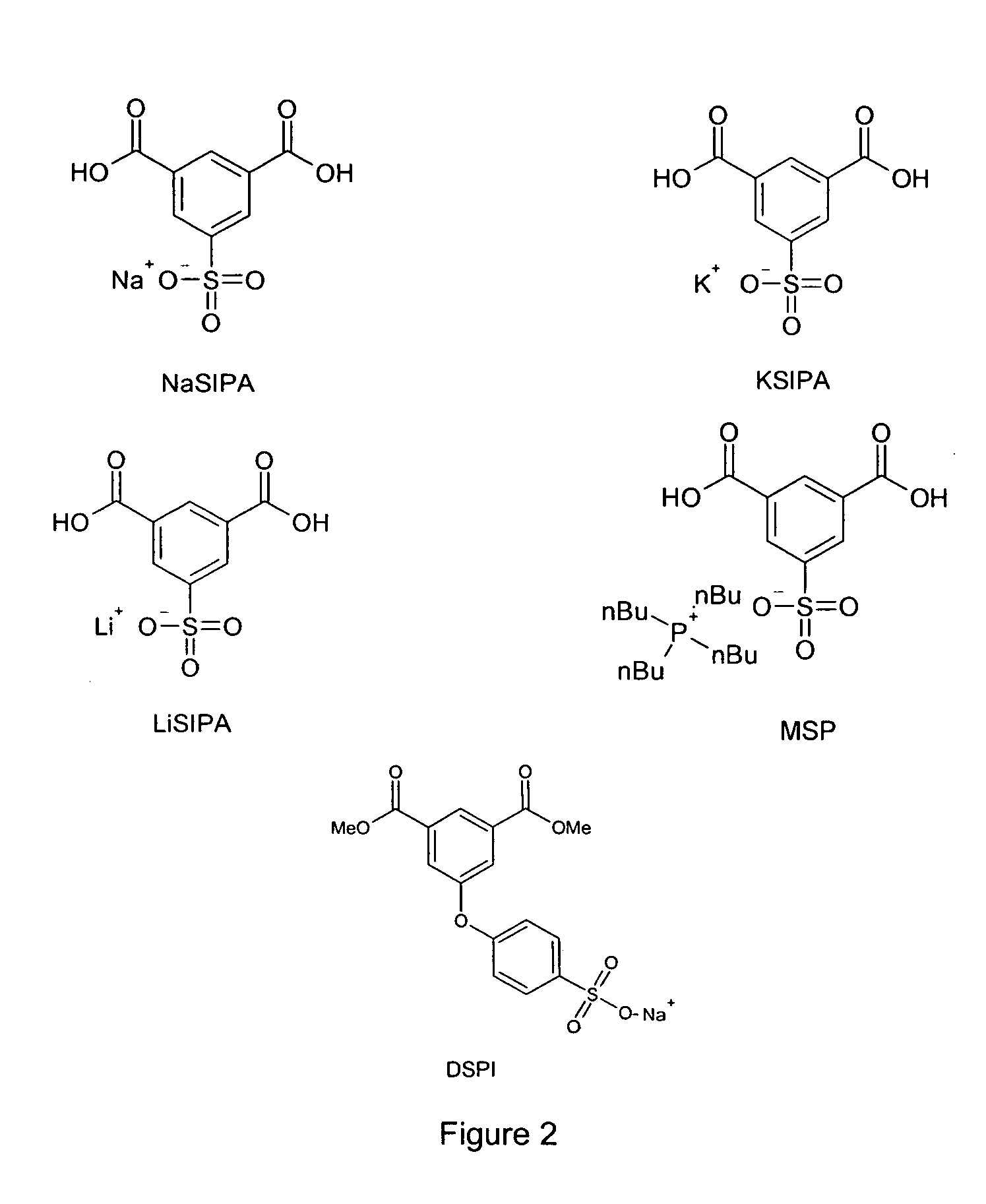Use of copolymerizable sulfonate salts to promote char formation in polyesters and copolyesters
- Summary
- Abstract
- Description
- Claims
- Application Information
AI Technical Summary
Problems solved by technology
Method used
Image
Examples
example 1
[0052]This example illustrates the preparation of a copolyester containing 99 mole % terephthalic acid, 1 mole % 5-sodiosulfoisophthalic acid, and 100 mole % ethylene glycol.
[0053]A mixture of 66.12 g (0.495 mol) dimethyl terephthalate, 1.34 g 5-sodiosulfoisophthalic acid (0.005 mol), 62.07 g of ethylene glycol (1.0 mole), and 100 ppm Ti in the form of titanium tetraisopropoxide was placed in a 500 milliliter flask equipped with an inlet for nitrogen, a metal stirrer, and a short distillation column. The flask was placed in a metal bath heated to 200° C. and the contents of the flask were heated at 185° C. for 2 hours, then at 200° C. for 2 hours, then heated up to 250° C. in 5 minutes. Once at 250° C., a vacuum of 100 mm Hg was gradually applied over the next hour. Once reaching 100 mm Hg, the temperature was increased to 270° C. and a vacuum of 0.45 mm Hg was applied over 5 minutes. Full vacuum was maintained for a total time of about 120 minutes to remove excess unreacted diol. A...
example 2
[0054]This example illustrates that 5-sodiosulfoisophthalic acid unexpectedly promotes char formation in copolyesters.
[0055]Poly(ethylene terephthalate)s modified with increasing amounts of 5-sodiosulfoisophthalic acid (NaSIPA) were prepared in a method similar to that described in Example 1. These copolyesters were all made with 100 ppm titanium in the form of titanium tetraisopropoxide as the catalyst. Char formation was analyzed by thermogravimetric analysis (TGA) at 600° C. Samples were heated at a rate of 20° C. / min in a TGA under a nitrogen flow of 50 cc / min. Char data is shown in Table 1. The thermal data indicates that at low modifications of 5-sodiosulfoisophthalic acid, a large enhancement in char is observed. For example, a 0.4 mole % modification of poly(ethylene terephthalate) with 5-sodiosulfoisophthalic acid resulted in a 66% increase in char at 600° C. Addition of 5-sodiosulfoisophthalic acid also decreased the temperature at 10% loss.
TABLE 1Char formation of polyeth...
example 3
[0056]This example illustrates the preparation of a copolyester containing 99 mole % terephthalic acid, 1 mole % 5-sodiosulfoisophthalic acid, 62 mole % ethylene glycol and 12 mole % 1,4-cyclohexanedimethanol.
[0057]A mixture of 96 g (0.495 mol) dimethyl terephthalate, 1.48 g 5-sodium sulfoisophthalic acid (0.005 mol), 58.2 g of ethylene glycol (0.938 mol), 8.90 g 1,4-cyclohexanedimethanol (0.062 mol), 46 ppm Mn in the form of manganese acetate, 23 ppm P in the form of a phosphate ester and 32 ppm Ti in the form of titanium tetraisopropoxide was placed in a 500 milliliter flask equipped with an inlet for nitrogen, a metal stirrer, and a short distillation column. The flask was placed in a Wood's metal bath heated to 200° C. and the contents of the flask were heated at 185° C. for 2 hours, then at 200° C. for 2 hours, then heated up to 250° C. in 5 minutes. Once at 250° C., a vacuum of 100 mm Hg was gradually applied over the next hour. Once reaching 100 mm Hg, the temperature was inc...
PUM
| Property | Measurement | Unit |
|---|---|---|
| Temperature | aaaaa | aaaaa |
| Percent by mass | aaaaa | aaaaa |
| Percent by mass | aaaaa | aaaaa |
Abstract
Description
Claims
Application Information
 Login to View More
Login to View More - R&D
- Intellectual Property
- Life Sciences
- Materials
- Tech Scout
- Unparalleled Data Quality
- Higher Quality Content
- 60% Fewer Hallucinations
Browse by: Latest US Patents, China's latest patents, Technical Efficacy Thesaurus, Application Domain, Technology Topic, Popular Technical Reports.
© 2025 PatSnap. All rights reserved.Legal|Privacy policy|Modern Slavery Act Transparency Statement|Sitemap|About US| Contact US: help@patsnap.com



